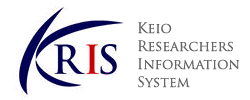-
Affiliation
-
Faculty of Science and Technology, Department of System Design Engineering (Yagami)
-
Position
-
Associate Professor

KEIO RESEARCHERS INFORMATION SYSTEM |
Details of a Researcher
このページはJavascriptを使用しています。すべての機能を使用するためにはJavascript を有効にする必要があります。
Koike, Ryo
|
|
|
Keio University, Faculty of Science and Engineering, Department of System Design Engineering, Research Associate (Temporary)
Keio University, Faculty of Science and Engineering, Department of System Design Engineering, Senior Assistant Professor
Keio University, Faculty of Science and Engineering, Department of System Design Engineering, Associate Professor
Keio University, Faculty of Science and Engineering, Department of System Design Engineering
University, Graduated
Keio University, The Graduate School of Science and Technology, Integrated Design Engineering
Graduate School, Completed, Master's course
Keio University, The Graduate School of Science and Technology, Integrated Design Engineering
Graduate School, Completed, Doctoral course
Yokota M., Takemura S., Koike R., Maki T., Takaki K., Mori T., Hirono Y., Kakinuma Y.
CIRP Journal of Manufacturing Science and Technology 61 114 - 127 2025.10
ISSN 17555817
Denkena B., Wichmann M., Malek T., Nguyen H.N., Kato M., Isshiki K., Koike R., Kakinuma Y.
Journal of Manufacturing Science and Engineering 146 ( 7 ) 2024.07
ISSN 10871357
Jiang X., Koike R.
Heliyon 10 ( 11 ) 2024.06
ISSN 24058440
Metal Additive Manufacturing Improved in High Gravitational Fields
Koike R.
Yosetsu Gakkai Shi Journal of the Japan Welding Society 93 ( 7 ) 429 - 434 2024
ISSN 00214787
Hashimoto M., Koike R., Kakinuma Y., Hirono Y., Mori T., Oda Y.
Procedia CIRP 124 227 - 230 2024
ISSN 22128271
Metal 3D printing by powder bed fusion applying artificial gravity control
Koike, Ryo
科学研究費補助金研究成果報告書 2021
Koike, Ryō
科学研究費補助金研究成果報告書 2018
Development of a time-domain simulation for laser metal 3D printer based on a particle method
Koike, Ryo
学事振興資金研究成果実績報告書 (慶應義塾大学) 2017
Submicron-Scale Metal 3D Fabrication via High-Gravitational PBF Using Metal Nanoparticles
基盤研究(B), Principal investigator
Low-density foam metal fabrication based on net-zero gravity process
MEXT,JSPS, Grant-in-Aid for Scientific Research, 基盤研究(B), Principal investigator
Metal 3D printing by powder bed fusion applying artificial gravity control
MEXT,JSPS, Grant-in-Aid for Scientific Research, Grant-in-Aid for Early-Career Scientists , Principal investigator
Development of direct deposition for porous structure based on molten-metal dynamics analysis with particle method
MEXT,JSPS, Grant-in-Aid for Scientific Research, Grant-in-Aid for Young Scientists (B), Principal investigator
合金固液相変化を解析する指向性エネルギー堆積法シミュレータの開発
MEXT,JSPS, Grant-in-Aid for Scientific Research, Grant-in-Aid for Research Activity Start-up , Principal investigator
SEMINAR IN SYSTEM DESIGN ENGINEERING
2025
MACHINE DESIGN
2025
LABORATORIES IN SYSTEM DESIGN ENGINEERING 2)
2025
LABORATORIES IN SYSTEM DESIGN ENGINEERING 1)
2025
INTRODUCTION TO SYSTEM DESIGN ENGINEERING
2025